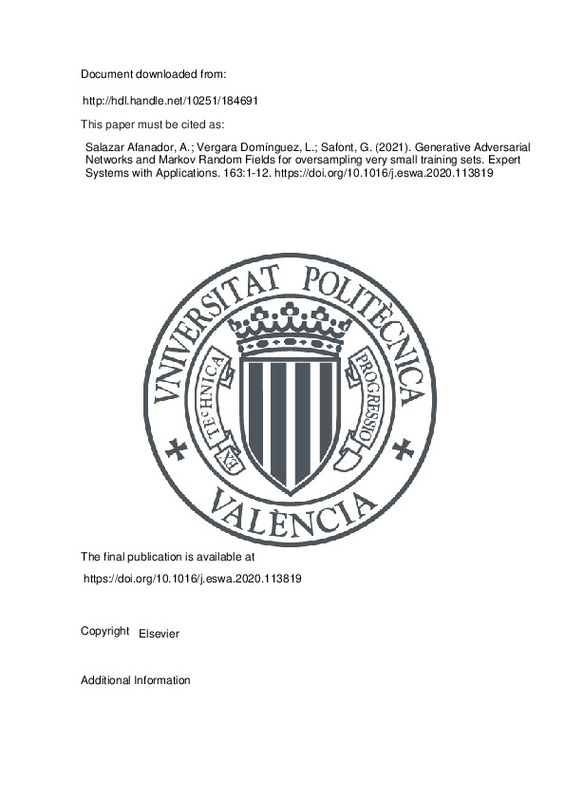JavaScript is disabled for your browser. Some features of this site may not work without it.
Buscar en RiuNet
Listar
Mi cuenta
Estadísticas
Ayuda RiuNet
Admin. UPV
Generative Adversarial Networks and Markov Random Fields for oversampling very small training sets
Mostrar el registro sencillo del ítem
Ficheros en el ítem
| dc.contributor.author | Salazar Afanador, Addisson
|
es_ES |
| dc.contributor.author | Vergara Domínguez, Luís
|
es_ES |
| dc.contributor.author | Safont, Gonzalo
|
es_ES |
| dc.date.accessioned | 2022-07-22T18:06:11Z | |
| dc.date.available | 2022-07-22T18:06:11Z | |
| dc.date.issued | 2021-01 | es_ES |
| dc.identifier.issn | 0957-4174 | es_ES |
| dc.identifier.uri | http://hdl.handle.net/10251/184691 | |
| dc.description.abstract | [EN] In this work, we propose a new method for oversampling the training set of a classifier, in a scenario of extreme scarcity of training data. It is based on two concepts: Generative Adversarial Networks (GAN) and vector Markov Random Field (vMRF). Thus, the generative block of GAN uses the vMRF model to synthesize surrogates by the Graph Fourier Transform. Then, the discriminative block implements a linear discriminant on features measuring clique similarities between the synthesized and the original instances. Both blocks iterate until the linear discriminant cannot discriminate the synthetic from the original instances. We have assessed the new method, called Generative Adversarial Network Synthesis for Oversampling (GANSO), with both simulated and real data in experiments where the classifier is to be trained with just 3 or 5 instances. The applications consisted of classification of stages of neuropsychological tests using electroencephalographic (EEG) and functional magnetic resonance imaging (fMRI) data and classification of sleep stages using electrocardiographic (ECG) data. We have verified that GANSO can effectively improve the classifier performance, while the benchmark method SMOTE is not appropriate to deal with such a small size of the training set. | es_ES |
| dc.description.sponsorship | This work was supported by Spanish Administration (Ministerio de Ciencia, Innovacion y Universidades) and European Union (FEDER) under grant TEC2017-84743-P. | es_ES |
| dc.language | Inglés | es_ES |
| dc.publisher | Elsevier | es_ES |
| dc.relation.ispartof | Expert Systems with Applications | es_ES |
| dc.rights | Reconocimiento - No comercial - Sin obra derivada (by-nc-nd) | es_ES |
| dc.subject | Classifier training | es_ES |
| dc.subject | Oversampling | es_ES |
| dc.subject | Generative adversarial networks | es_ES |
| dc.subject | Markov random fields | es_ES |
| dc.subject.classification | TEORIA DE LA SEÑAL Y COMUNICACIONES | es_ES |
| dc.title | Generative Adversarial Networks and Markov Random Fields for oversampling very small training sets | es_ES |
| dc.type | Artículo | es_ES |
| dc.identifier.doi | 10.1016/j.eswa.2020.113819 | es_ES |
| dc.relation.projectID | info:eu-repo/grantAgreement/AEI/Plan Estatal de Investigación Científica y Técnica y de Innovación 2013-2016/TEC2017-84743-P/ES/METODOS INFORMADOS PARA LA SINTESIS DE SEÑALES/ | es_ES |
| dc.rights.accessRights | Abierto | es_ES |
| dc.contributor.affiliation | Universitat Politècnica de València. Departamento de Comunicaciones - Departament de Comunicacions | es_ES |
| dc.contributor.affiliation | Universitat Politècnica de València. Instituto Universitario de Telecomunicación y Aplicaciones Multimedia - Institut Universitari de Telecomunicacions i Aplicacions Multimèdia | es_ES |
| dc.description.bibliographicCitation | Salazar Afanador, A.; Vergara Domínguez, L.; Safont, G. (2021). Generative Adversarial Networks and Markov Random Fields for oversampling very small training sets. Expert Systems with Applications. 163:1-12. https://doi.org/10.1016/j.eswa.2020.113819 | es_ES |
| dc.description.accrualMethod | S | es_ES |
| dc.relation.publisherversion | https://doi.org/10.1016/j.eswa.2020.113819 | es_ES |
| dc.description.upvformatpinicio | 1 | es_ES |
| dc.description.upvformatpfin | 12 | es_ES |
| dc.type.version | info:eu-repo/semantics/publishedVersion | es_ES |
| dc.description.volume | 163 | es_ES |
| dc.relation.pasarela | S\462762 | es_ES |
| dc.contributor.funder | AGENCIA ESTATAL DE INVESTIGACION | es_ES |
| dc.contributor.funder | European Regional Development Fund | es_ES |







![[Cerrado]](/themes/UPV/images/candado.png)

